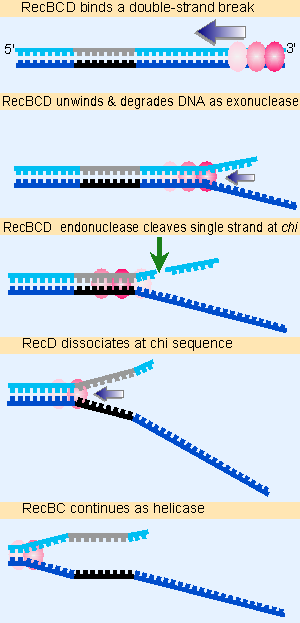5. The bacterial RecBCD system is stimulated by chi sequences
14.5 The bacterial RecBCD system is stimulated by chi sequences |
To analyze the nature of the events involved in exchange of sequences between DNA molecules, we must turn to bacterial systems. Here the recognition reaction is part and parcel of the recombination mechanism and involves restricted regions of DNA molecules rather than intact chromosomes. But the general order of molecular events is similar: a single strand from a broken molecule interacts with a partner duplex; the region of pairing is extended; and an endonuclease resolves the partner duplexes. Enzymes involved in each stage are known, although they probably represent only some of the components required for recombination.
Bacterial enzymes implicated in recombination have been identified by the occurrence of rec V mutations in their genes. The phenotype of Rec V mutants is the inability to undertake generalized recombination. Some 10 V20 loci have been identified.
Bacteria do not usually exchange large amounts of duplex DNA, and there may be various routes to initiate recombination in prokaryotes. In some cases, DNA may be available with free single-stranded 3′ ends: DNA may be provided in single-stranded form (as in conjugation, discussed in 12 The replicon); single-stranded gaps may be generated by irradiation damage; or single-stranded tails may be generated by phage genomes undergoing replication by a rolling circle. However, in circumstances involving two duplex molecules (as in recombination at meiosis in eukaryotes), single-stranded regions and 3′ ends must be generated.
One mechanism for generating suitable ends has been discovered as a result of the existence of certain hotspots that stimulate recombination. They were discovered in phage lambda in the form of mutants, called chi, that have single base-pair changes creating sites that stimulate recombination. These sites lead us to the role of other proteins involved in recombination.
These sites share a constant nonsymmetrical sequence of 8 bp:
5′ GCTGGTGG 3′
3′ CGACCACC 5′
The chi sequence occurs naturally in E. coli DNA about once every 5 V10 kb. Its absence from wild Vtype lambda DNA, and also from other genetic elements, shows that it is not essential for recombination.
A chi sequence stimulates recombination in its general vicinity, say within a distance of up to 10 kb from the site. A chi site can be activated by a double-strand break made several kb away on one particular side (to the right of the sequence as written above). This dependence on orientation suggests that the recombination apparatus must associate with DNA at a broken end, and then can move along the duplex in only one direction.
chi sites are targets for the action of an enzyme coded by the genes recBCD. This complex exercises several activities. It is a potent nuclease that degrades DNA, originally identified as the activity exonuclease V. It has a helicase activity that can unwind duplex DNA in the presence of SSB; and it has an ATPase activity. Its role in recombination may be to provide a single-stranded region with a free 3′ end.
 |
Figure 14.9 RecBCD nuclease approaches a chi sequence from one side, degrading DNA as it proceeds; at the chi site, it makes an endonucleolytic cut, loses RecD, and retains only the helicase activity. |
Figure 14.9 shows how these reactions are coordinated on a substrate DNA that has a chi site. When RecBCD binds DNA on the right site of chi, it moves along unwinding the DNA. It degrades the released single strand with the 3′ end. When it reaches the chi site, it pauses and cleaves one (the top) strand of the DNA at a position between 4 and 6 bases on the right. The top strand of the chi site is recognized in single-stranded form. Recognition of the chi site causes the RecD subunit to dissociate or become inactivated, as a result of which the enzyme loses its nuclease activity. However, it continues to function as a helicase.